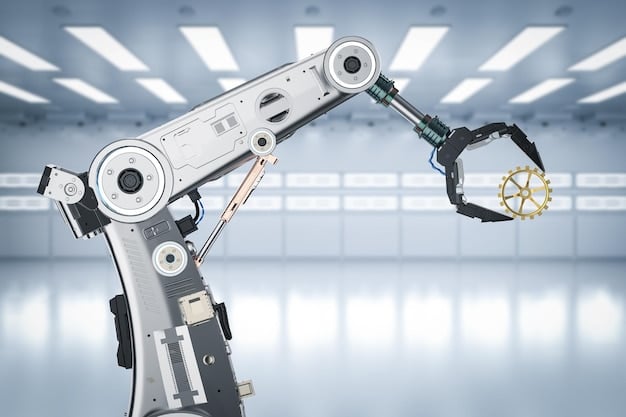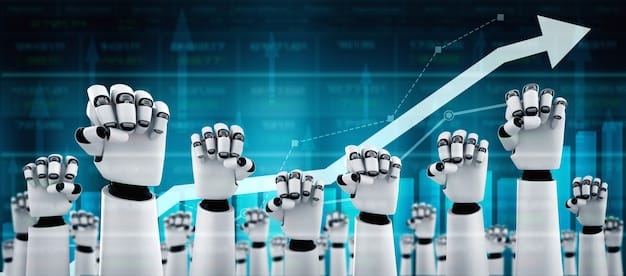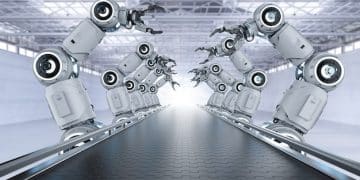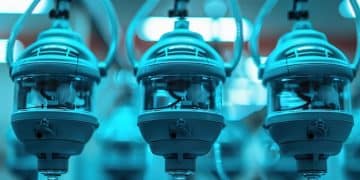The Future of Robotics in US Manufacturing: A 5-Year Forecast

The Future of Robotics in US Manufacturing: A 5-Year Forecast predicts significant advancements and integration of robotic systems across various sectors of US manufacturing, driven by automation needs, technological improvements, and economic factors.
What does the future hold for robotics in US manufacturing? This article delves into The Future of Robotics in US Manufacturing: A 5-Year Forecast, exploring the trends and changes that will shape the industry.
The Rise of Automation in US Factories
The US manufacturing sector has been undergoing a significant transformation, with automation becoming increasingly prevalent. This shift is driven by the need for greater efficiency, higher productivity, and improved quality control. Robotics plays a crucial role in this automation trend.
Robotics is changing how factories operate, allowing manufacturers to optimize processes, reduce costs, and enhance safety. As technology evolves, the integration of robots is expected to accelerate, fundamentally altering the nature of work in the manufacturing sector.
Key Drivers of Robotic Adoption
Several factors are fueling the adoption of robotics by US manufacturers. Understanding these drivers is essential to forecasting the future trends.
- Labor Shortages: The manufacturing sector faces a growing shortage of skilled labor, making automation an attractive solution.
- Cost Reduction: Robots can perform tasks more efficiently and consistently than humans, leading to significant cost savings.
- Enhanced Productivity: Robots can operate 24/7 without fatigue, boosting overall productivity and output.
- Improved Safety: Robots can handle dangerous or repetitive tasks, reducing the risk of workplace injuries.
The demand for increased efficiency and precision, combined with the rising costs of labor, continues to drive the need for robotics and automation technologies in US manufacturing facilities. This trend is set to reshape the industry over the next five years.
Technological Advancements in Robotics
The capabilities of robots are rapidly advancing, opening up new possibilities for their application in manufacturing. These advancements include improved sensors, artificial intelligence (AI), and machine learning (ML).
These technological improvements enable robots to perform more complex tasks, adapt to changing environments, and collaborate effectively with human workers. The integration of these technologies is transforming the way robots are used in manufacturing.

AI and Machine Learning Integration
AI and ML are revolutionizing robotics by enabling robots to learn from data and adapt to new situations. This integration is leading to more intelligent and autonomous robots.
Robots equipped with AI can perform tasks such as quality inspection, predictive maintenance, and process optimization. These capabilities enhance efficiency and reduce downtime in manufacturing operations.
- Improved Decision-Making: AI enables robots to make better decisions based on real-time data.
- Enhanced Adaptability: ML allows robots to adapt to changing environments and tasks.
- Predictive Maintenance: AI algorithms can predict when equipment needs maintenance, reducing downtime.
The combination of AI and robotics is creating new opportunities for automation, enabling manufacturers to achieve higher levels of efficiency, precision, and flexibility. This trend is expected to accelerate in the coming years.
Economic Impact of Robotics on US Manufacturing
The adoption of robotics has a significant economic impact on the US manufacturing sector. By increasing productivity and reducing costs, robots help manufacturers compete in the global market.
This economic impact extends beyond individual companies, benefiting the entire US economy through job creation, innovation, and economic growth. Understanding this impact is crucial for assessing the long-term sustainability of robotics adoption.
Job Creation and Displacement
One of the most debated aspects of robotics adoption is its impact on employment. While some jobs may be displaced, new jobs are also created in areas such as robot design, manufacturing, and maintenance.
The net impact on employment depends on various factors, including the rate of adoption, the types of jobs affected, and the availability of retraining programs. The long-term economic benefits of robotics adoption are likely to outweigh the short-term challenges.

- New Job Roles: Robotics creates new jobs in areas such as robot programming, maintenance, and system integration.
- Increased Productivity: Higher productivity leads to increased demand and potential job growth.
- Retraining Programs: Investing in retraining programs can help workers adapt to new roles in the automated workplace.
The economic impact of robotics on US manufacturing is complex and multifaceted. While the adoption of robotics may lead to some job displacement, it also creates new opportunities for employment and economic growth. By investing in education and training, the US can maximize the benefits of robotics while minimizing the negative impacts.
Challenges and Opportunities
While the future of robotics in US manufacturing looks promising, there are also several challenges and opportunities to consider. These include technical challenges, regulatory issues, and workforce development needs.
Addressing these challenges and capitalizing on the opportunities will be crucial for ensuring the successful integration of robotics into the US manufacturing sector. Failure to do so could hinder progress and limit the potential benefits of automation.
Addressing Technical Challenges
One of the main challenges is the complexity of integrating robots into existing manufacturing systems. This requires overcoming technical barriers and developing new solutions for interoperability and communication.
Another challenge is the need for more sophisticated sensors and software, as well as improved robot dexterity and agility. Overcoming these technical challenges will require ongoing research and development efforts.
Technical challenges in robotics integration can include:
- Interoperability: Ensuring that robots can communicate and work with existing manufacturing systems.
- Sensor Technology: Developing more advanced sensors to improve robot perception and decision-making.
- Software Development: Creating robust and user-friendly software for robot programming and control.
By addressing these technical challenges, the US can unlock the full potential of robotics and maintain its competitive edge in the global manufacturing market.
Policy and Regulatory Considerations
Government policies and regulations play a crucial role in shaping the adoption of robotics in US manufacturing. These policies can either promote or hinder the integration of robots, depending on their design and implementation.
Areas of concern include safety standards, labor laws, and tax incentives for automation investments. A balanced regulatory framework is needed to encourage innovation while protecting workers and ensuring fair competition.
Incentivizing Robotics Adoption
Governments can provide tax incentives, grants, and other forms of support to encourage manufacturers to invest in robotics. These incentives can help offset the initial costs of automation and accelerate the adoption of robots.
Incentives can also be targeted at specific industries or regions, helping to address local economic challenges and promote innovation. The goal is to create a business-friendly environment that fosters the growth of the robotics industry.
Government initiatives should focus on:
- Tax Incentives: Providing tax breaks for investments in robotics and automation.
- Grant Programs: Offering grants for research and development of new robotics technologies.
- Workforce Development: Investing in training programs to prepare workers for the automated workplace.
By creating a supportive policy environment, the US can encourage manufacturers to embrace robotics and reap the economic benefits of automation.
Predictions for the Next 5 Years
Based on current trends and technological advancements, several predictions can be made about the future of robotics in US manufacturing over the next five years. These predictions include increased adoption, greater collaboration, and new applications.
By understanding these trends, manufacturers can prepare for the future and capitalize on the opportunities that robotics offers. A proactive approach is essential for staying competitive in the rapidly evolving manufacturing landscape.
Increased Adoption and Integration
The adoption of robotics is expected to accelerate in the coming years, driven by the factors discussed earlier in this article. This will lead to a greater integration of robots into various aspects of manufacturing operations.
Robots will be used not only for repetitive tasks but also for more complex and specialized operations. This increased integration will require greater collaboration between humans and robots.
The 5-year forecast includes:
- Wider Adoption: More manufacturers will adopt robotics to improve efficiency and reduce costs.
- Greater Integration: Robots will be integrated into more aspects of manufacturing operations.
- Human-Robot Collaboration: Human workers and robots will collaborate more closely to achieve common goals.
The future of robotics in US manufacturing is bright, with the potential to transform the industry and create new opportunities for economic growth and innovation.
| Key Point | Brief Description |
|---|---|
| ⚙️ Automation Growth | Increased automation is expected across US manufacturing sectors. |
| 🤖 AI Integration | AI and machine learning will enhance robot capabilities. |
| 💰 Economic Impact | Robotics will significantly impact job creation and economic growth. |
| 🏢 Policy Support | Government policies are crucial for successful robotics adoption. |
Frequently Asked Questions
▼
Key drivers include labor shortages, cost reduction, and the need for enhanced productivity and safety in manufacturing operations.
▼
AI and machine learning will enable robots to make better decisions, adapt to changing environments, and perform predictive maintenance, improving overall efficiency.
▼
Robotics increases productivity and reduces costs, helping US manufacturers compete globally, creating jobs, and fostering economic growth.
▼
Challenges include the complexity of integrating robots into existing systems, and the need for more advanced sensors and software. Addressing interoperability is key.
▼
Government policies like tax incentives, grant programs, and workforce development initiatives can encourage manufacturers to invest in and adopt robotics technologies.
Conclusion
In summary, the Future of Robotics in US Manufacturing: A 5-Year Forecast points to a landscape characterized by increased automation, enhanced productivity, and evolving workforce dynamics. Overcoming challenges and embracing new opportunities will be crucial for US manufacturers to maintain competitiveness and drive economic growth in the years ahead.





